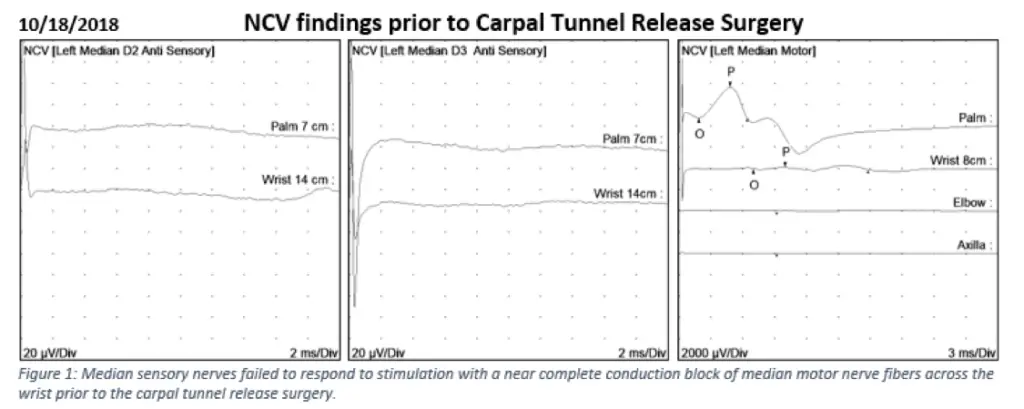The most common cause for numbness, tingling, and pain of the hand is due to a compressed median nerve at or through the carpal tunnel.1 There are many clinical tests that can be performed to aid in the diagnosis of carpal tunnel syndrome, including the square sign test, carpal tunnel compression test, Phalen’s test, or Hoffmann-Tinel.2 These test can be misleading with poor sensitivities and specificities. Unlike these subjective tests Nerve Conduction Studies and Electromyography (NCS/EMG) can provide a more objective manner of evaluating the median nerve through the carpal tunnel.3 Consider how the baseline pre-op to post-op findings might show objective proof that a carpal tunnel release surgery has improved nerve health.
The figure below shows the findings seen with NCS testing of the median nerve of a 44-year-old male prior to having a carpal tunnel release surgery performed. The median sensory nerves failed to respond to stimulation, with a near complete block of median motor nerve fiber conduction across the wrist.

This next set of images shows the findings seen with NCV testing of the median nerve 2 years after the carpal tunnel release surgery was performed. These findings are quite remarkable. Even though there continues to be slowing through the carpal tunnel with the median sensory and motor nerves, the fact that the sensory responses have returned and the motor amplitudes are now normal across the carpal tunnel speaks to the efficacy of the surgery.

When a diagnosis of carpal tunnel syndrome has been determined there are many forms of treatment and management available. Those often include, ergonomic setups with keyboarding, wrist splinting during the day and/or night, decrease of repetitive movements, referrals to physical or occupational therapy, and encouragement of weight loss. If these options fail, then glucocorticoid injections or carpal tunnel release surgery is often needed.
NCS/EMG testing not only aides in the diagnosis and prognosis of carpal tunnel syndrome but can provide proof of improved nerve function with either conservative measures or surgical release. This objective measure offers physicians a greater measure of confidence in the clinical decision-making process.
Although carpal tunnel syndrome is the most common form of nerve entrapment, other differential diagnosis that should be considered with hand numbness, tingling, and pain include tendonitis, tenosynovitis, cubital tunnel syndrome, Guyon’s canal syndrome, cervical radiculopathy, or peripheral polyneuropathy.2
Knowing whether there is true nerve involvement, exactly where the problem lies, and how severe the compromise might be will further help delineate whether conservative care or a surgery is needed. NCV and EMG testing continues to provide the best information for practitioners to make correct decisions on diagnosis and prognosis with regards to nerve entrapments, as was seen in the case above.
- Fuller, D. (2020, March 25). Orthopedic Surgery for Carpal Tunnel Syndrome. Retrieved June 17, 2020, from https://emedicine.medscape.com/article/1243192-overview
- Sevy JO, Varacallo M. Carpal Tunnel Syndrome. [Updated 2020 Mar 30]. In: StatPearls [Internet]. Treasure Island (FL): StatPearls Publishing; 2020 Jan-. Available from: https://www.ncbi.nlm.nih.gov/books/NBK448179/
- Sonoo, M., Menkes, D. L., Bland, J., & Burke, D. (2018). Nerve conduction studies and EMG in carpal tunnel syndrome: Do they add value?. Clinical neurophysiology practice, 3, 78–88. https://doi.org/10.1016/j.cnp.2018.02.005
Kyle J. Martinos PT, DPT, ECS



